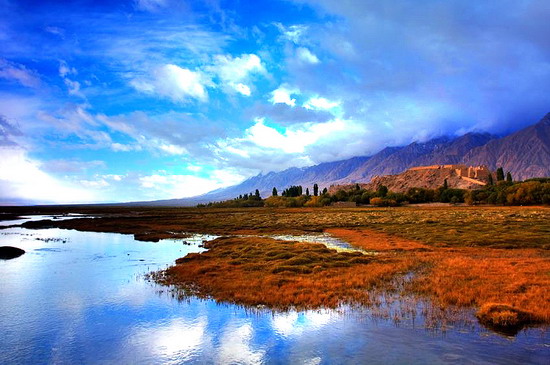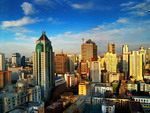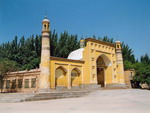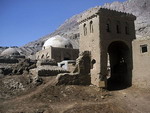
Xinjiang - a unique historical and cultural region of China
Xinjiang - Uygur Autonomous Region (XUAR) is the largest administrative-territorial unit of China. It occupies almost the whole north-western part of the country, covering the territories from Tien Shan to Mongolia. The total area of XUAR exceeds 1,500,000. Over its whole history, the region formed part of many great medieval states and many times, changed its name for: Uyguria, Turkic Khaganate, Uygurstan, Uygur Khaganate, and Eastern Turkestan. XUAR is the name, the Uygurs, who dislike its official name, prefer themselves to call their region.
The history of Xinjiang is inextricably connected with the Chinese history, however, over many centuries Eastern Turkestan was rather an opponent of the Heavenly Empire, until it was annexed to the Empire of Great Qing as late as at the end of the XVIII century. It was at that period, when the official name Xinjiang (New border) was brought into being.
The history of Eastern Turkestan is the history of the Great Silk Road, because it was this ancient transcontinental trade route that gave an impulse for development of this culture to start. The beginning of the II century BC saw the construction of caravanserais, small fortified trade points and military fortresses which subsequently developed into major cities of Eastern Turkestan. Besides, XUAR is the location of ancient written and architectural monuments of Buddhist culture, brought by Buddhist monks-pilgrims from India.
Even now, many historical places and sights of Xinjiang are shrouded with century-long mysteries. The majority of them are hidden amidst the sands of one of the world’s most dangerous deserts - the Takla-Makan Desert whose outskirts are occupied by many cities of Xinjiang. However, in spite of the fact that the Xinjiang nature is severe enough, it represents a bright contrast between the deserts and picturesque green oases, where Eastern Turkestan lies.
Xinjiang is notable not only with its architectural monuments and ruins of ancient cities, but also with its inimitable culture. In spite of numerous efforts of Chinese authorities, the Uygur people managed to preserve their culture unchanged. Today, by visiting Xinjiang, you will find yourself in the world of silk and spices, where you can hear a muezzin calling for Morning Prayer at daybreak, and at night, you will be able to watch the sun setting in the desert. Eastern Turkestan is the world of contrasts, where ancestors’ customs and traditions neighbor on modern trends.
Up to date XUAR is one of the main tourist centers of China. Tourists from all over the world are coming there to see the unique architectural monuments such as Gaochang, the Caves of Thousand Buddhas, ruins of ancient cities on the Great Silk Road and so on. Furthermore one of the most interesting tours to Xinjiang is a trip by caravan roads through the Takla-Maklan Desert, which enables to plunge into the atmosphere of medieval East for a short time.
Eastern Turkestan or Xinjiang in Chinese is not just a part of the territory of China; it is a unique historical and cultural region, whose history is closely connected with the history of the Great Silk Road.
Cities of the Xinjiang region
Urumqi, China
 Urumqi is considered the main industrial centers of Xinjiang. Unlike the other cities of the autonomous region, it has almost no historical landmarks, but the city differs with its infrastructure and modern architecture. Perhaps, it is the only city in Xinjiang which is more Uygurian, rather than Chinese one. Probably, that is why the Uygur themselves consider the heart of Xinjiang is Kashgar city, where they managed to follow their traditions and customs, and its streets still preserve its history up to date.
Urumqi is considered the main industrial centers of Xinjiang. Unlike the other cities of the autonomous region, it has almost no historical landmarks, but the city differs with its infrastructure and modern architecture. Perhaps, it is the only city in Xinjiang which is more Uygurian, rather than Chinese one. Probably, that is why the Uygur themselves consider the heart of Xinjiang is Kashgar city, where they managed to follow their traditions and customs, and its streets still preserve its history up to date.
More on Urumqi
Kashgar, China
 The city of Kashgar is located in the oasis of the same name, in the uttermost western part of the Tarim Basin. It is fed by three rivers: the Kashgar, Gezdarya and Hantereksu. Almost from all sides, the city is surrounded by the mountains of Tien Shan in the north and Kun-Lun in the south, while in the east, there lies the Takla Makan desert. The climate is relatively dry, but all the same this Kashgar oasis is one of the most fertile places in Xinjiang.
The city of Kashgar is located in the oasis of the same name, in the uttermost western part of the Tarim Basin. It is fed by three rivers: the Kashgar, Gezdarya and Hantereksu. Almost from all sides, the city is surrounded by the mountains of Tien Shan in the north and Kun-Lun in the south, while in the east, there lies the Takla Makan desert. The climate is relatively dry, but all the same this Kashgar oasis is one of the most fertile places in Xinjiang.
More on Kashgar
Turpan, China
 Turpan is a unique city. It is located in the Turpan Basin at the depth of 154 m below sea level. From all sides the city is surrounded by deserts and mountains, destroyed medieval towns and ruins of ancient settlements. The area, the city is situated on, is called the Valley of Winds: the pressure inside the cavity differs much from the pressure outside it, while a rapid movement of air flow generates a strong vortex. This makes a trip through the valley somewhat uncomfortable, though, the local community learned how to adapt to it long ago.
Turpan is a unique city. It is located in the Turpan Basin at the depth of 154 m below sea level. From all sides the city is surrounded by deserts and mountains, destroyed medieval towns and ruins of ancient settlements. The area, the city is situated on, is called the Valley of Winds: the pressure inside the cavity differs much from the pressure outside it, while a rapid movement of air flow generates a strong vortex. This makes a trip through the valley somewhat uncomfortable, though, the local community learned how to adapt to it long ago.
More on Turpan
Aksu, China
Modern Xinjiang is one of the Chinese popular recreation centers for tourists from all over the world. They come there not only to learn about the amazing culture of the region, but also go on an unforgettable journey to the cities located on the Great Silk Road. One of the most popular tourist routes is the one from Urumqi to Kashgar through the Takla-Makan Desert. In the course of this trip you can visit such cities as Kuchar and Aksu, famous for their landmarks and ruins of ancient temples.
More on Aksu
Hotan, China
Among the horizonless sands of the Takla-Makan Desert, in the south-west of Xinjiang Uighur Autonomous region of China there is Hotan city located in an ancient oasis. The city’s history is closely connected with the Great Silk Road. This was one the largest transfer points on the caravan way, and also one of the centers producing silk which was imported to China.
More on Hotan
Kuchar, China
In the north of Xinjiang there lies one of the ancient cities of Eastern Turkestan – Kuchar. In ancient time it was the capital of the state with the same name. This region was inhabited by people of different nationalities, professing different religions. But the greatest influence on all aspects of the resident population was exerted by the Great Silk Road.
More on Kuchar
Cherchen (Qiemo), China
The city of Cherchen (Qiemo in Chinese) is found in the Xinjiang Uighur Autonomous region of China in the southern part of the Takla Makan Desert. The city is located in the oasis of the same name next to the Cherchen River. Once, the city was one of the most important trade and transit centers on the Great Silk Road. A huge section of the Silk Road southern branch from Dunhuang to Cherchen was considered one of the most complicated and dangerous for trade caravans, since there was no large community for the tired travelers to take rest.
More on Cherchen
Hami (Kumul), China
To the north-west to Xinjiang-Uygur Autonomous region there is the city of Hami (Kumul). The city’s population exceeds 404,000 people. It is considered an important road junction of the Lanzhou-Xinjiang railway. Furthermore, this is one of the largest industrial and agricultural centers of the region.
More on Hami
Yarkand (Shache), China
In the western outskirt of the Takla-Makan Desert, in the Yarkand River water gap there lies one of the ancient cities on the southern branch of the Great Silk Road. Yarkand city, or Shache in Chinese, is one of the largest cities of Xinjiang-Uygur Autonomous region of China.
More on Yarkand
Karghalik, China
Karghalik is the name of a small town, located on the Yarkand River in Xinjiang Uygur Autonomous Region. Karghalik or Chinese Yecheng is a county in Kashgar district, bordered on the Taklimakan Desert. Its population is about 370,000. The total area is 26,600 km2.
More on Khargalik
Shihez, China
Shihezi was granted the status of a city only in 1947, when the first rural settlements sprang up there. The community gradually began to expand and built the first industrial enterprises, which provided the locals with jobs. Thus, Shihezi grew rapidly and became the second largest city in modern Xinjiang.
More on Shihezi

